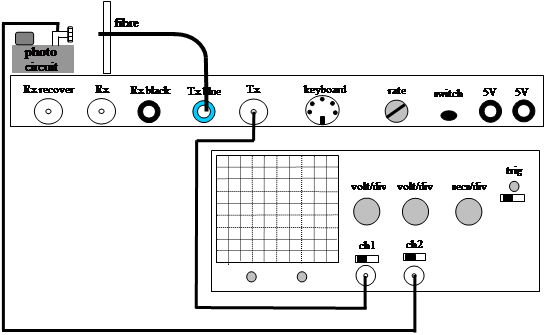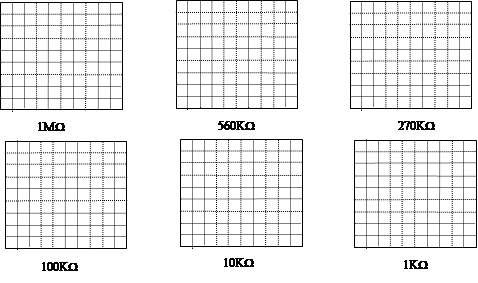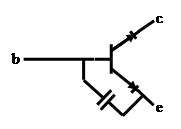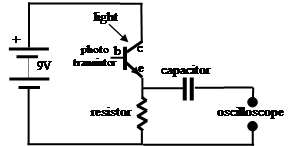Photodiodes and phototransistors are used extensively to detect light pulses and convert them into digital electrical signals. In an optical fibre network these signals can be used directly by computers or converted into analog voice signals in a telephone.
Light meters or sensors on cameras use photodiodes.
One of the most common uses is in CD or DVD players to pick up the signal reflected from the digital encoding on the disc.

Figure 3.16.Optical signal recovery from a CD using a photodiode.
A photodiode is ideal for very fast signals but gives a much lower output signal. The phototransistor is used in the kit as it provides an amplified signal output and the signals studied tend to be relatively slow.

Figure 3.17 Structure of a photodiode, symbol and a negative bias operating circuit
All PN junctions are light sensitive. When a photon strikes the junction in a photodiode electrons are released and the formation of (positive) holes occurs.
If the two sides of the junction are connected a current flows. A photodiode is constructed from layers of p and n type silicon housed to allow light to strike the junction.

Figure 3.18 Phototransistor structure, symbol and operating circuit
In a phototransistor photons strike the base region of the transistor. This causes current to flow through the collector/emitter circuit and in effect amplification occurs. The base connection is not usually connected.
Phototransistors, figure 3.19 come in a variety of forms and may resemble a LED with only two leads. Try the device both ways round.

Figure 3.19 Phototransistor pin outs
Refer to figure 3.18 and build the circuit on the breadboard so the phototransistor faces the white LED on the optical table as shown in figure 3.20.
The phototransistor is a BPX 43 and the pin out is shown in figure 3.19.
Start off with R1 at 1MW and record the voltage level on the meter.
If the photodiode is too close to the LED the device may saturate and not respond to the light level. Replace the resistor with the other values available in turn; taking care not to move the positions of the components. Complete the table.
resistor |
1MW |
560KW |
270KW |
100KW |
10KW |
1KW |
volts |
|
|
|
|
|
|
Plot a graph to show the voltage output against the resistor value. It may be necessary to take background light levels into account.

Figure 3.20 Phototransistor and LED on the optical bench
The response of the phototransistor to different light levels can be investigated by selecting a resistor that gives close to maximum output (but doesn't saturate). Place neutral density filters between the phototransistor and the LED.
% transmission |
100 |
50 |
25 |
13 |
7 |
Voltage output |
|
|
|
|
|
To extend the number of samples use combinations of the filters Calculate the percentage transmission of each filter combination.
Plot a graph to display the results and explain the shape of the graph. Think of a suitable application for a detector of this type. It may be necessary to take background light levels into account.
The frequency response to pulses of light or changes in light levels is important in many applications. The phototransistor can be configured to give different response rates. Set up the optical bench and oscilloscope as shown in figure 3.21.

Figure 3.21 Pulse response rates.
The light output from a length of fibre inserted in the digital transmitter should cause a response on the oscilloscope screen. The oscilloscope should be attached to the output from the phototransistor.
Oscilloscope settings are Trigger None, Volts /Div 5V and Secs Div typically 20mS at the low flash rate and 100uS/div at the maximum rate.
Start with the 1MW resistor and note the response at the maximum and minimum flash rates. Sketch the waveforms seen on the oscilloscope.

Replace the 1MW Resistor with the other values and repeat the exercise.

Figure 3.22 Electronic model of a phototransistor
Try to explain why the output pulses have changed at the higher flash rates. Reference to figure 3.22 may help.
As a further experiment switch between the DC-GND-AC switch on the oscilloscope and note what happens to the display.

Figure 3.23 De-coupling capacitor used to remove DC
Switch back to DC and modify the phototransistor circuit with a 0.15uF capacitor between the output and oscilloscope lead as shown in figure 3.23.
Explain the action of the capacitor. This is a very important property used later in the construction of transistor amplifiers.
Source: http://www.snscourseware.org/snsct/files/CW_59085b75e0d0a/Photodiodes%20and%20Phototransistors.doc
Web site to visit: http://www.snscourseware.org/
Author of the text: indicated on the source document of the above text
If you are the author of the text above and you not agree to share your knowledge for teaching, research, scholarship (for fair use as indicated in the United States copyrigh low) please send us an e-mail and we will remove your text quickly. Fair use is a limitation and exception to the exclusive right granted by copyright law to the author of a creative work. In United States copyright law, fair use is a doctrine that permits limited use of copyrighted material without acquiring permission from the rights holders. Examples of fair use include commentary, search engines, criticism, news reporting, research, teaching, library archiving and scholarship. It provides for the legal, unlicensed citation or incorporation of copyrighted material in another author's work under a four-factor balancing test. (source: http://en.wikipedia.org/wiki/Fair_use)
The information of medicine and health contained in the site are of a general nature and purpose which is purely informative and for this reason may not replace in any case, the council of a doctor or a qualified entity legally to the profession.
The texts are the property of their respective authors and we thank them for giving us the opportunity to share for free to students, teachers and users of the Web their texts will used only for illustrative educational and scientific purposes only.
All the information in our site are given for nonprofit educational purposes